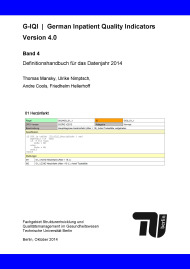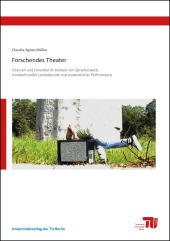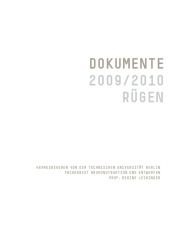G-IQI – German Inpatient Quality Indicators. Version 4.0 – Band 4
Definitionshandbuch für das Datenjahr 2014

Publishing year: 2015
Volume 4 of the fourth revision and extension of the German Inpatient Quality Indicators (G-IQI 4.0) contains the exact indicator definitions based on the German coding system for the year 2014. Thus volume 4 is an extension to the previously published volume 3, 2nd edition, which contains the detailed explanations of the G-IQI system and various evaluations for the German hospitals (http://nbn-resolving.de/urn:nbn:de:kobv:83-opus4-42797). By concept and definition the G-IQI indicators are constructed in a way, that they can be derived from existing administrative data. In Germany, these are available due to the DRG billing process, which covers all inpatient cases except psychiatry. Data are available on the hospital level, at insurers and due to respective legal regulations on the national level (data sets according to §21 KHEntgG and §301 SGB V). G-IQI provide a comprehensive and medically meaningful overview over important and/or frequent inpatient services. They inform about volume and wherever possible about outcome. The G-IQI indicators cover about 42% of all German inpatient cases, which is more than in all other disease-specific indicator systems. The mortality indicators cover over 51% of all inpatient deaths. Besides the user guide and technical specifications volume 3, 2nd ed., also presents an evaluation of the German national DRG data. Thus national reference values and inpatient volumes can be given for all G-IQI indicators (listed in Anhang 1 of volume 1). This provides new information about the state of medical care for many diseases in Germany, which otherwise is not available on a national level. Indicator systems like G-IQI may be used for public reporting. In this way G-IQI is currently utilized voluntarily in Germany by the ‘Initiative Qualitätsmedizin’ and obligatory in Switzerland (via the Swiss variant CH-IQI) for all hospitals by the ‘Bundesamt für Gesundheit’. Furthermore, deviations of outcome from national reference values for certain quality indicators within a hospital may be used to induce further investigations of treatment processes within the hospital in order to find ways for improvement. G-IQI together with internal peer review procedures can be used to build up a very efficient and powerful outcome-oriented quality management system within a hospital. Volume 3, 2nd ed., also outlines how such a system can be set up.



